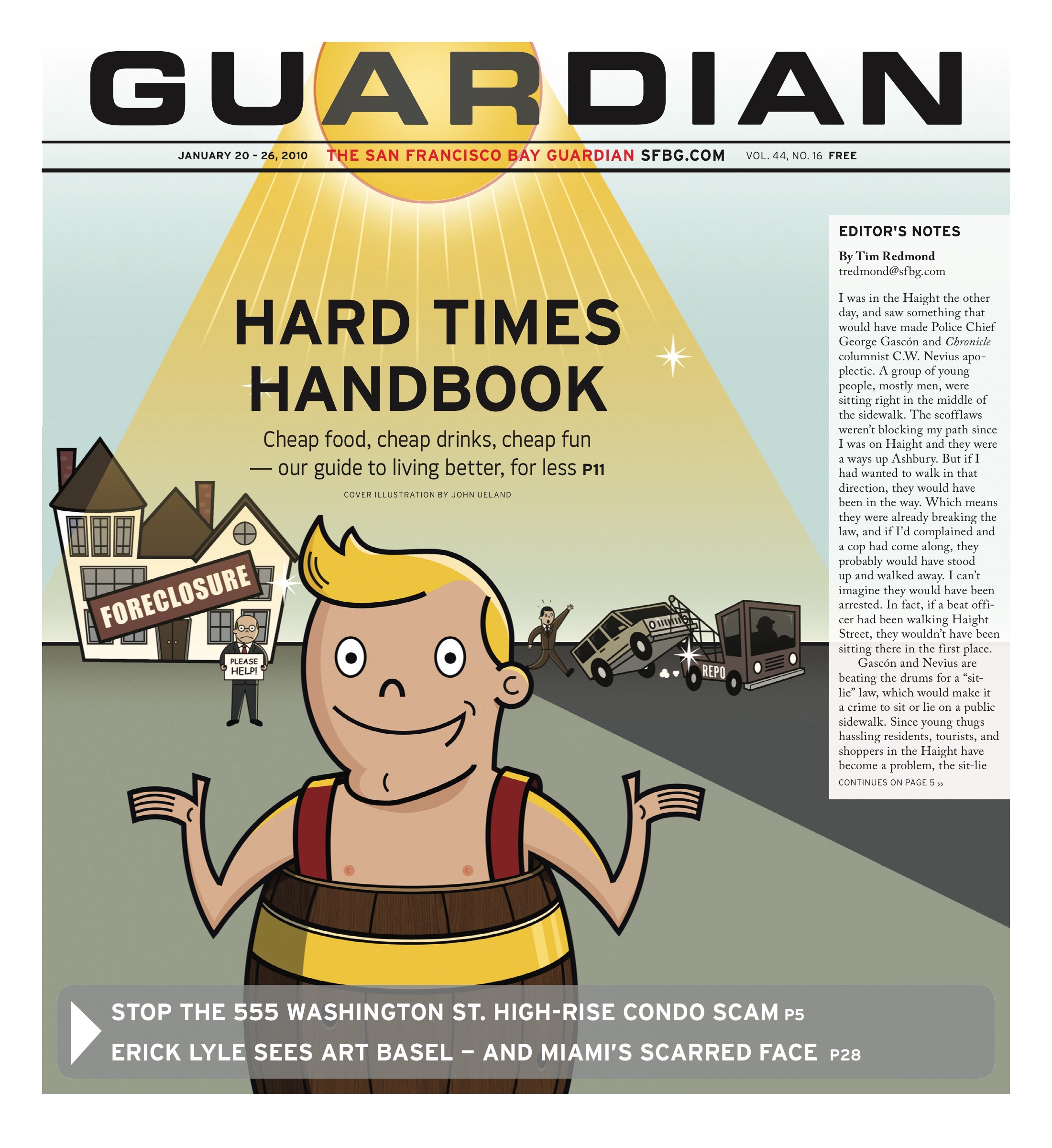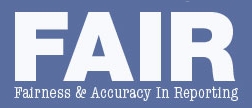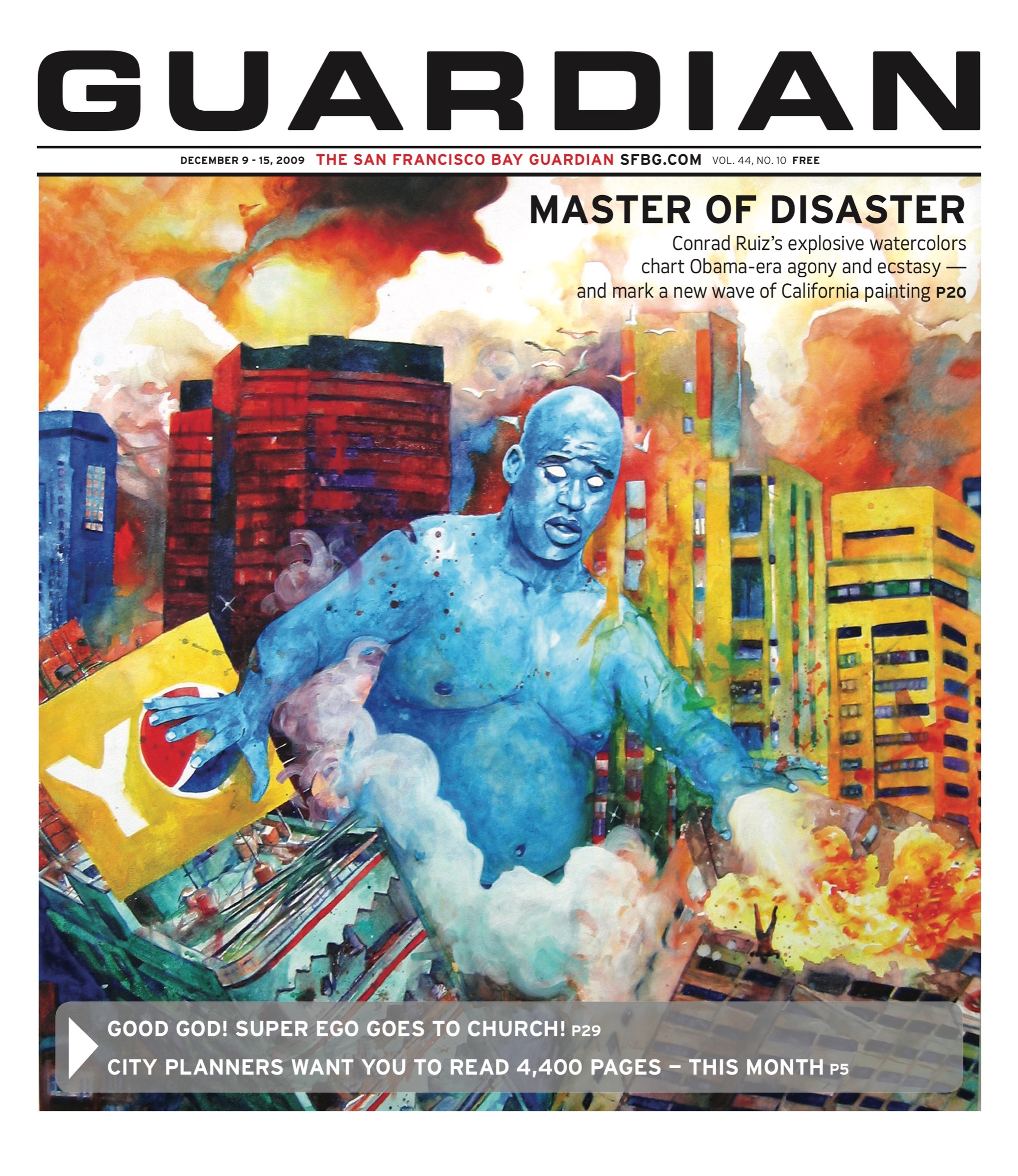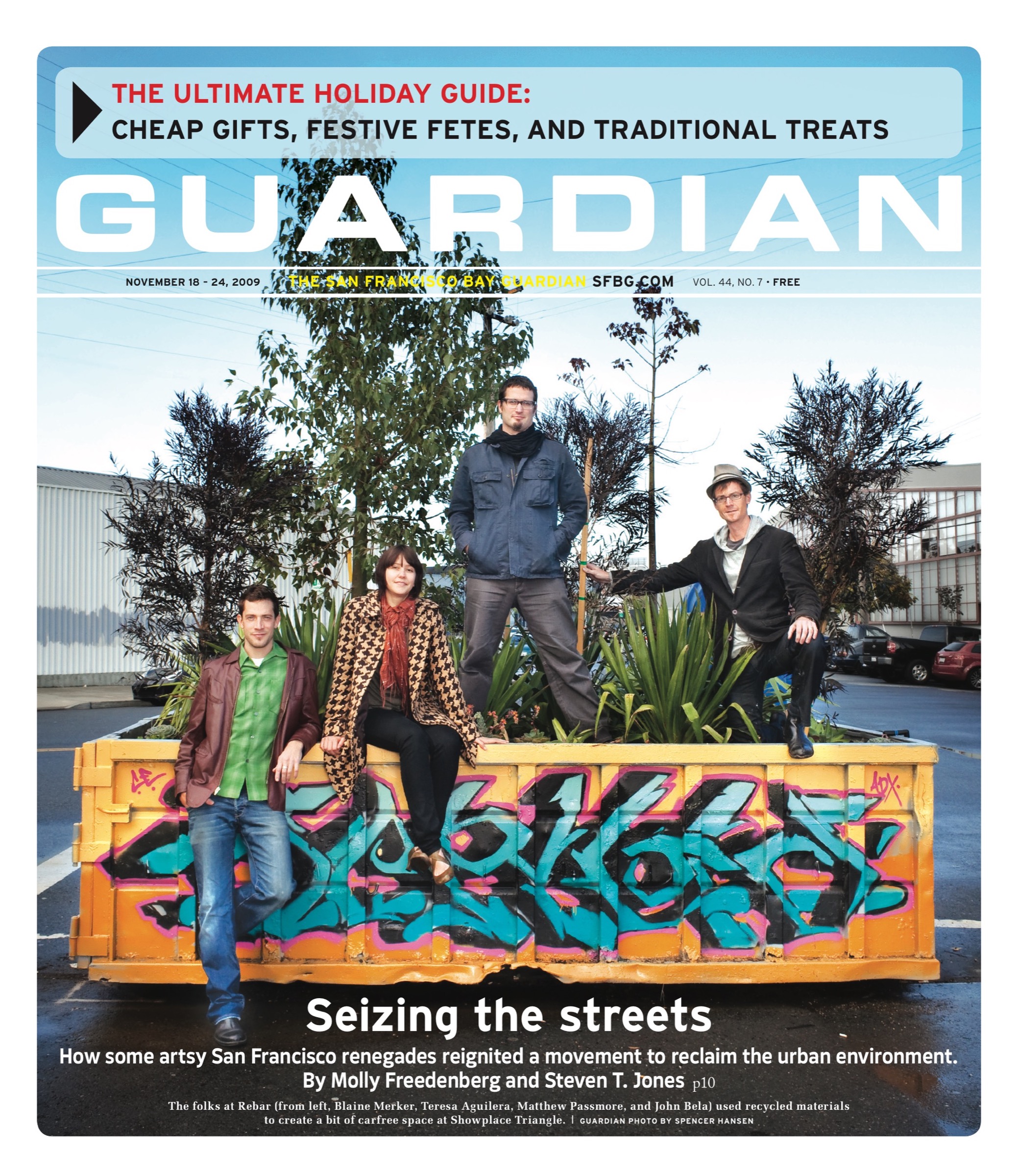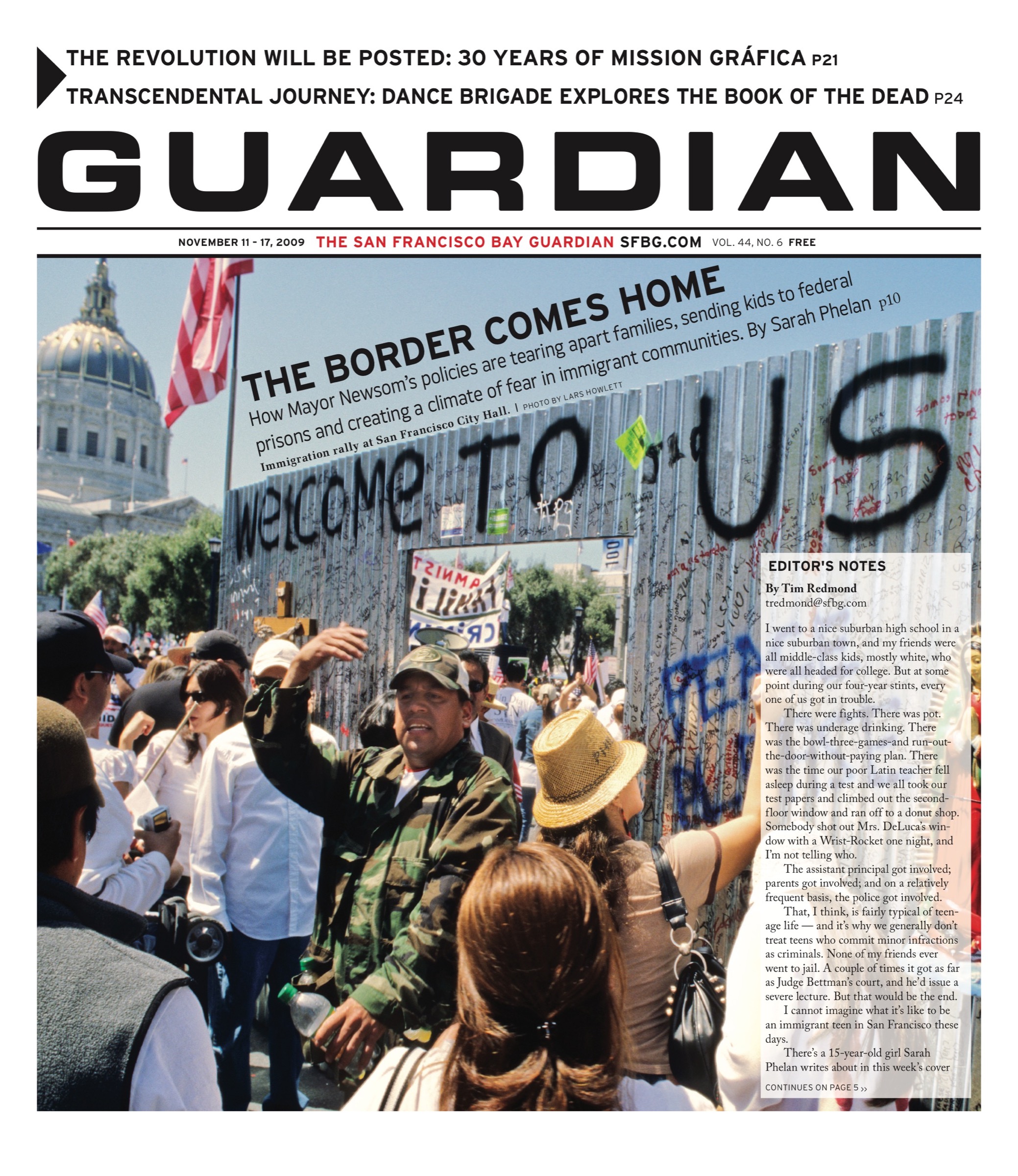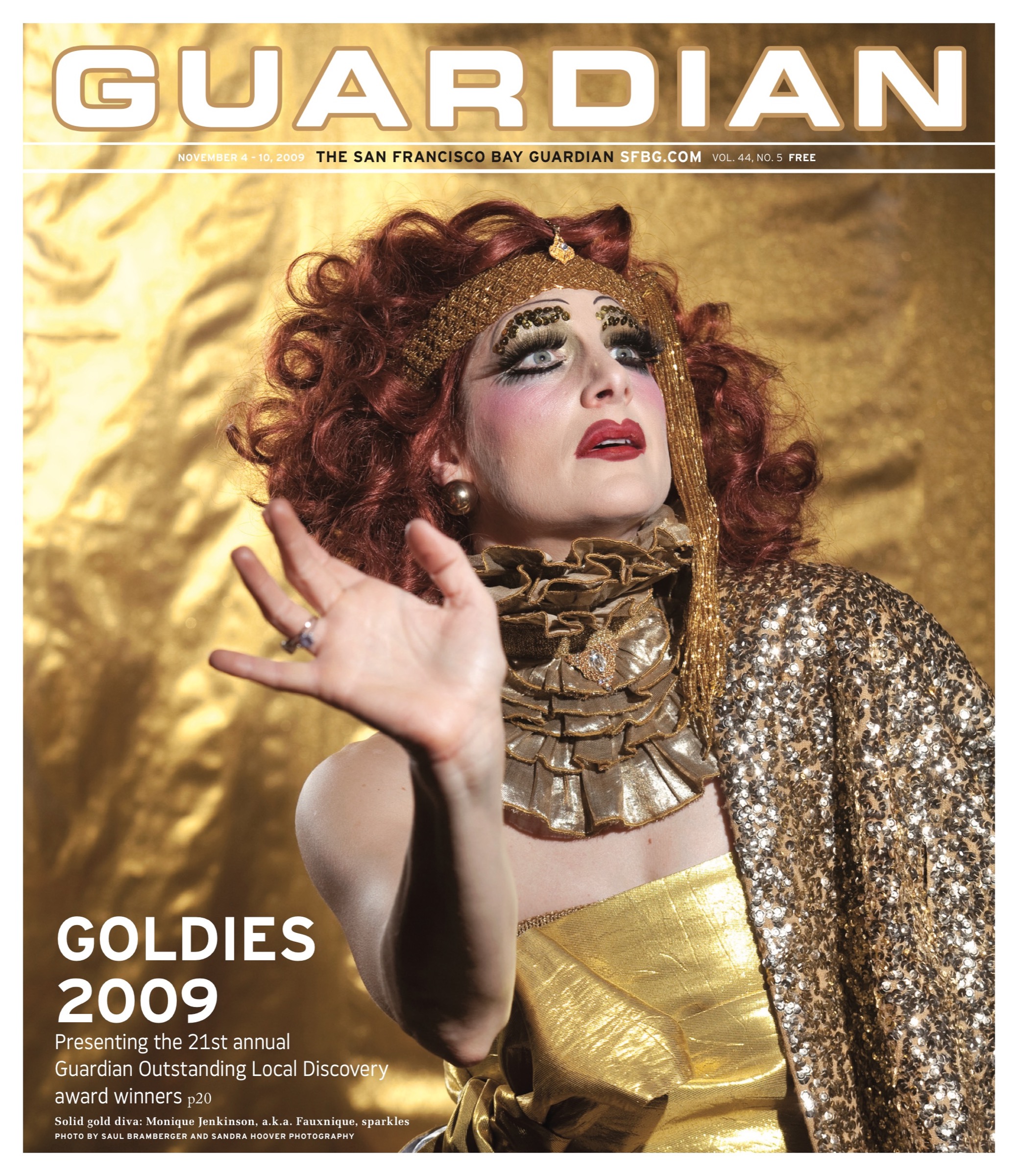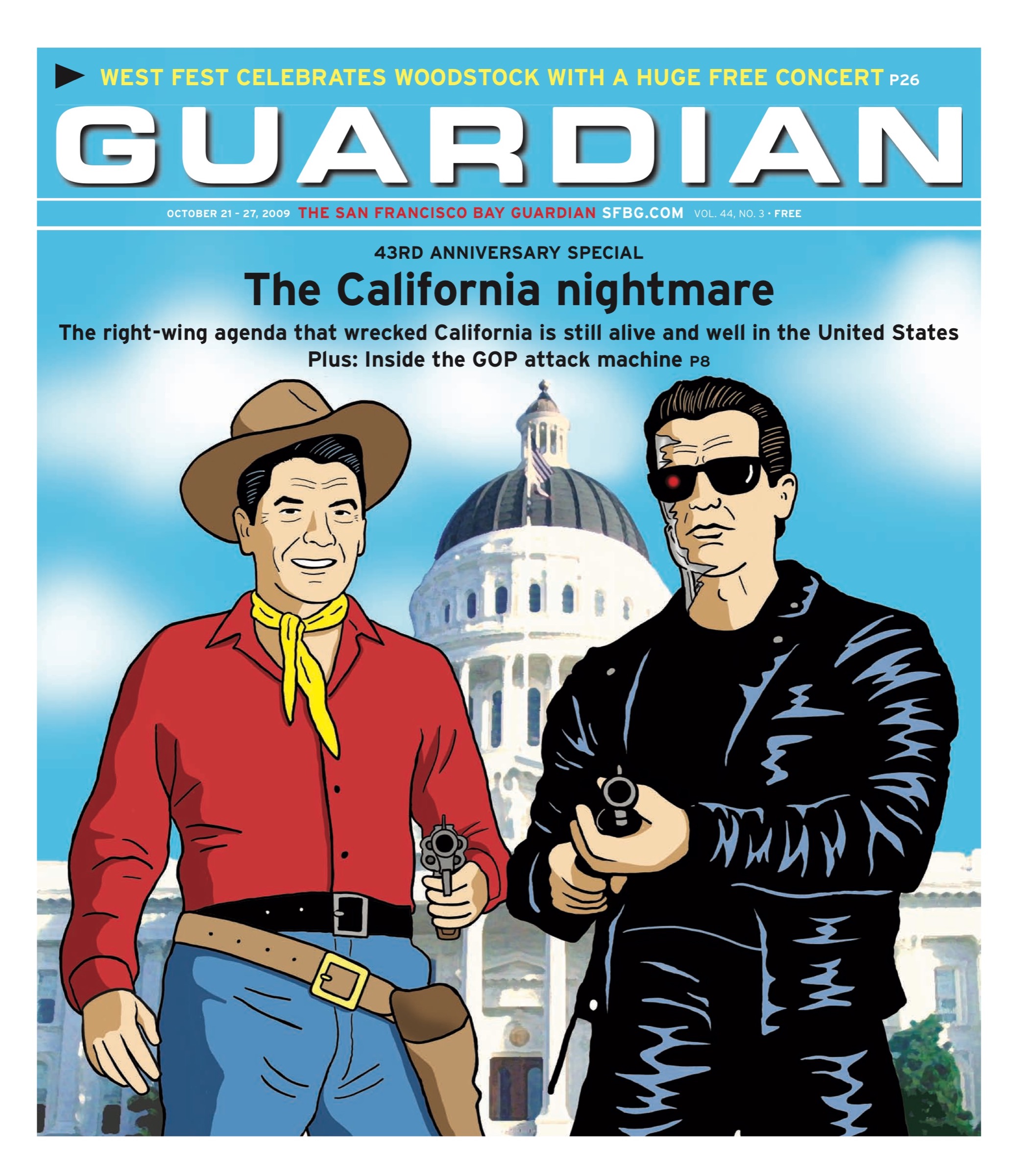Music listings are compiled by Paula Connelly and Cheryl Eddy. Since club life is unpredictable, it’s a good idea to call ahead to confirm bookings and hours. Prices are listed when provided to us. Submit items at listings@sfbg.com.
WEDNESDAY 16
ROCK/BLUES/HIP-HOP
Altarboys, Midnight Bombers, Inferno of Joy Annie’s Social Club. 9pm, $7.
*Bad Brains, P.O.S., Trouble Andrew Slim’s. 8pm, $26.
Pete Bernhard, Leopold and His Fiction, Erin Brazil Rickshaw Stop. 8pm, $8.
Dave the Pastor Dalton, Mike and Ruthy, Meri St. Mary, Virgil Shaw Hotel Utah. 8pm, $6.
Disastroid, Solid, Sticks and Stones Elbo Room. 9pm, $6.
Every Time I Die, Bring Me the Horizon, Oh Sleeper, Architects Regency Ballroom. 8pm, $20.
Global Noize Boom Boom Room. 9:30pm, $15.
Joshua James and Cory Chisel Independent. 9pm, $12.
Jinx and Jezzebelle Simple Pleasures, 3434 Balboa, SF; (415) 387-4022. 8pm, free.
Light Machine, Charlie Gone Mad, Black Eagle Trust Red Devil Lounge. 8pm, $5.
Love Language, All Smiles Café du Nord. 8:30pm, $10.
Oh My God, Highway Patrol, Wave Array Hemlock Tavern. 9pm, $7.
Okmoniks, Magnetix, Wau y Los Arrgghs, Rantouls Knockout. 9pm, $9.
Tip of the Top Rasselas Jazz. 8pm, free.
Todd Wolfe Biscuits and Blues. 8pm, $15.
Yourself and the Air, Excuses for Skipping, Mister Loveless Bottom of the Hill. 9pm, $10.
BAY AREA
Bonnie Raitt and Taj Mahal Paramount Theatre. 8pm, $39.75-59.75.
JAZZ/NEW MUSIC
"B3 Wednesdays" Coda. 9pm, $7. With Sylvia Cuenca Organ Trio.
Cat’s Corner Savanna Jazz. 7pm, $5-10.
Dr. Lonnie Smith Trio Yoshi’s San Francisco. 8 and 10pm, $22.
Leigh Gregory Plough and Stars. 9pm, free.
Ben Marcato and the Mondo Combo Top of the Mark. 7:30pm, $10.
"San Francisco Electronic Music Festival" Brava Theater, 2781 24th St, SF; www.sfemf.org. 7pm, $10-17. With Miya Masaoka, Lukas Ligeti, and Amy X Neuburg.
Tin Cup Serenade Le Colonial, 20 Cosmo Place, SF; (415) 931-3600. 7pm, free.
FOLK/WORLD/COUNTRY
Freddy Clarke Peña Pachamama, 1630 Powell, SF; (415) 646-0018. 8pm, $12. Latin, Middle Eastern funk.
DANCE CLUBS
Booty Call Q-Bar, 456 Castro; www.bootycallwednesdays.com. 9pm. Juanita Moore hosts this dance party, featuring DJ Robot Hustle.
Fringe Madrone Lounge. 9pm, free. With DJs subOctave and Blondie K spinning the best of indie rock and classic new wave.
Hands Down! Bar on Church. 9pm, free. With DJs Claksaarb, Mykill, and guests spinning indie, electro, house, and bangers.
Jam Wednesday Infusion Lounge. 9pm, free. With DJ Slick D.
Qoöl 111 Minna Gallery. 5-10pm, $5. Pan-techno lounge with DJs Spesh, Gil, Hyper D, and Jondi.
RedWine Social Dalva. 9pm-2am, free. DJ TophOne and guests spin outernational funk and get drunk.
Respect Wednesdays End Up. 10pm, $5. Rotating DJs Lonestar Sound, Young Fyah, Sake One, Serg, and more spinning reggae, dancehall, roots, lovers rock, and mash ups.
Synchronize Il Pirata, 2007 16th St.; (415) 626-2626. 10pm, free. Psychedelic dance music with DJs Helios, Gatto Matto, Psy Lotus, Intergalactoid, and guests.
THURSDAY 17
ROCK/BLUES/HIP-HOP
Blank Slates, Jank, Warren Teagarden Hotel Utah. 9pm, $8.
Blues Traveler Fillmore. 8pm, $27.50.
Buxter Hoot’n, David and Joanna, Nathan Hughes El Rio. 10pm, $5.
Chairlift, Magic Bullets, El Ten Eleven Bottom of the Hill. 9pm, $15.
Terry Hanck Biscuits and Blues. 8pm, $15.
Happy Mondays, Psychedelic Furs, Amusement Parks on Fire Regency Ballroom. 8pm, $35.
Hundred Days, Trophy Fire, Atlantic Line Knockout. 9:30pm, $5.
Jahlectrik, Big Lion, Erica Sunshine Lee Red Devil Lounge. 8pm, $8.
Monotonix, Triclops, Anavan Independent. 8pm, $15.
Phoenix, Soft Pack Warfield. 8pm, $32.
Rademacher, Young Hunting, Gold Medalists Hemlock Tavern. 9pm, $6.
*Tarrakian, Christian Mistress, Meow Annie’s Social Club. 9pm, $7.
Telepath and Big Gigantic Boom Boom Room. 9:30pm, $10.
Throw Me the Statue, Brunettes, My First Earthquake Rickshaw Stop. 8pm, $12.
Turbonegra, Switchblade Riot, My Parade, DJ Squid Thee Parkside. 9pm, $6.
World/Inferno Friendship Society Great American Music Hall. 9pm, $15.
BAY AREA
*Avengers, Pansy Division, Paul Collins Beat Uptown. 9pm, $12.
Ben Harper and Relentless7 Fox Theater. 8pm, $35.
JAZZ/NEW MUSIC
Al Coster Trio Savanna Jazz. 8pm, $5.
Duuy Quintet Coda. 9pm, $7.
Eric Kurtzrock Trio Ana Mandara, Ghirardelli Square, 891 Beach, SF; (415) 771-6800. 7:30pm, free.
Mads Tolling Trio Shanghai 1930. 7pm, free.
Marlina Teich Trio Brickhouse, 426 Brannan, SF; (415) 820-1595. 7-10pm, free.
Stephen Merriman Simple Pleasures, 3434 Balboa, SF; (415) 387-4022. 8pm, free.
Sakai Yoshi’s San Francisco. 8pm, $14.
"San Francisco Electronic Music Festival" Brava Theater, 2781 24th St, SF; www.sfemf.org. 7pm, $10-17. With Mark Trayle, Donald Swearington, Maria Chavez, and Mason Bates.
Scott Amendola Trio with Jeff Parker and John Shifflet Café du Nord. 8pm, $15.
Stompy Jones Top of the Mark. 7:30pm, $10.
Bernie Worrell, Broun Fellinis Yoshi’s San Francisco. 10:30pm, $15.
FOLK/WORLD/COUNTRY
Rebecca Cross and the Saints, Stella Royale, New Map of the West Bollyhood Café. 9pm, free.
Flamenco Thursdays Peña Pachamama, 1630 Powell, SF; (415) 646-0018. 8pm, 9:30pm; $12.
Robyn Harris, Chris Trapper Dolores Park Café. 7:30pm, free.
Belle Monroe and Her Brewglass Boys Atlas Café. 8pm, free.
Tipsy House Plough and Stars. 9pm, free.
DANCE CLUBS
Afrolicious Elbo Room. 9:30pm, $5-6. DJs Pleasuremaker, Señor Oz, J Elrod, and B Lee spin Afrobeat, Tropicália, electro, samba, and funk.
Bingotopia Knockout. 7:30-9:30pm, free. Play for drinks and dignity with Lady Stacy Pants.
Caribbean Connection Little Baobab, 3388 19th St; 643-3558. 10pm, $3. DJ Stevie B and guests spin reggae, soca, zouk, reggaetón, and more.
Club Jammies Edinburgh Castle. 10pm, free. DJs EBERrad and White Mice spinning reggae, punk, dub, and post punk.
Drop the Pressure Underground SF. 6-10pm, free. Electro, house, and datafunk highlight this weekly happy hour.
Funky Rewind Skylark. 9pm, free. DJ Kung Fu Chris, MAKossa, and rotating guest DJs spin heavy funk breaks, early hip-hop, boogie, and classic Jamaican riddims.
Heat Icon Ultra Lounge. 10pm, free. Hip-hop, R&B, reggae, and soul.
Kick It Bar on Church. 9pm. Hip-hop with DJ Jorge Terez.
Koko Puffs Koko Cocktails, 1060 Geary; 885-4788. 10pm, free. Dubby roots reggae and Jamaican funk from rotating DJs.
Mestiza Bollywood Café, 3376 19th St., SF; (415) 970-0362. 10pm, free. Showcasing progressive Latin and global beats with DJ Juan Data.
Mirza Party and Soul Movers Infusion Lounge. 9pm, free. With DJ E Rock.
Popscene 330 Rich. 10pm, $10. Rotating DJs spinning indie, Britpop, electro, new wave, and post-punk.
Represent Icon Lounge. 10pm, $5. With Resident DJ Ren the Vinyl Archaeologist and DJs Green B, Daneekah, and Smoke 1.
Rock Candy Stud. 9pm-2am, $5. Luscious Lucy Lipps hosts this electro-punk-pop party with music by ReXick.
Toppa Top Thursdays Club Six. 9pm, $5. Jah Warrior, Jah Yzer, I-Vier, and Irie Dole spin the reggae jams for your maximum irie-ness.
FRIDAY 18
ROCK/BLUES/HIP-HOP
*Avengers, Pansy Division, Paul Collins Beat Bottom of the Hill. 10pm, $12.
Blue Rabbit, Marcus Very Ordinary, Gregg Tillery, Hoof and the Heel Hotel Utah. 9pm, $8.
Citizen Cope Fillmore. 9pm, $27.50.
Dead Guise Connecticut Yankee, 100 Connecticut, SF; www.theyankee.com. 9pm.
Drones, Model/Actress, Spyrals, DJ Duke of Windsor Café du Nord. 9:30pm, $10.
Grand Lake, White Cloud, Rad Cloud Hemlock Tavern. 9:30pm, $6.
Ice Cream Socialites Thee Parkside. 9pm, $6.
Illness, Sideshow Fiasco, Groundskeeper Kimo’s. 9pm, $6.
Pains of Being Pure at Heart, Depreciation Guild, Cymbals Eat Guitars Great American Music Hall. 9pm, $15.
Porcupine Tree, That 1 Guy Warfield. 9pm, $27.50-32.50.
Sea Wolf, Old-Fashioned Way, Sara Lov Bimbo’s 365 Club. 9pm, $15.
Shotty, Lipstick Conspiracy, Richie and the Curious Proclivities El Rio. 10pm, $5.
Timber Timbre, Harbours Rickshaw Stop. 6pm, $10.
"Your Music Magazine Band Olympicks" Red Devil Lounge. 9pm, $10.
BAY AREA
Miley Cyrus, Metro Station Oracle Arena, 7000 Coliseum Wy, Oakl; www.ticketmaster.com. 7pm, $39.50-79.50.
Furthur Fox Theater. 7:30pm, $49.50.
White Witch Canyon, 3rd Rail, 667 Uptown. 9pm, $10.
JAZZ/NEW MUSIC
Audium 9 1616 Bush, SF; (415) 771-1616. 8:30pm, $15.
Black Market Jazz Orchestra Top of the Mark. 9pm, $10.
"Cultural Encounters: Friday Nights at the deYoung presents Jazz at Intersection" Wilsey Court, de Young Museum, 50 Hagiwara Tea Garden Dr, SF; www.deyoungmuseum.org. 6:30pm, free. With Crushing Spiral Ensemble.
Eric Kurtzrock Trio Ana Mandara, Ghirardelli Square, 891 Beach, SF; 771-6800. 8pm, free.
Barry Finnerty and trio Savanna Jazz. 8pm, $5.
"Idle Warship: Talib Kweli, Res, and Graph Nobel" Yoshi’s San Francisco. 8 and 10pm, $16.
Jessica Johnson Shanghai 1930. 7:30pm, free.
Lucid Lovers Rex Hotel, 562 Sutter, SF; (415) 433-4434. 6-8pm.
"San Francisco Electronic Music Festival" Brava Theater, 2781 24th St, SF; www.sfemf.org. 7pm, $10-17. With Ed Osborn, Preshish Moments, Frank Bretschneider, and Joan La Barbara.
Lavay Smith and Her Red Hot Skillet Lickers Biscuits and Blues. 8 and 10pm, $20.
David Tranchina Simple Pleasures, 3434 Balboa, SF; (415) 387-4022. 8pm, free.
Will Bernard Band, Skerik Boom Boom Room. 9:30pm, $15.
FOLK/WORLD/COUNTRY
Bluegrass Bonanza Plough and Stars. 9pm. Presented by Shelby Ash.
Boca Do Rio Coda. 10pm, $10.
Brownout, Manicato, DJs Pleasuremaker and Señor Oz Elbo Room. 10pm, $10.
Crushing Spiral Ensemble deYoung Museum, Golden Gate Park, 50 Hagiwara Tea Garden Drive, SF; (415) 750-3600. 6:30pm, free.
Cuban Nights Peña Pachamama, 1630 Powell, SF; (415) 646-0018. 8:30pm, $15.
Shayle Matuda Dolores Park Café. 7:30pm, free.
Mestizo, Caravanserai: The Santana Tribute, Vortex Tribe feat. Mingo Lewis Slim’s. 8pm, $13.
"Methods of Defiance" Regency Ballroom. 9pm, $25-37.50. With Dr. Israel, Bernie Worrell, Toshinori Kondo, Hawkman, Guy Licata, and Bill Laswell.
Julia Nunes Swedish American Hall (upstairs from Café du Nord). 7:30pm, $15.
DANCE CLUBS
Activate! Lookout, 3600 16th St; (415) 431-0306. 9pm, $3. Face your demigods and demons at this Red Bull-fueled party.
Bar on Church 9pm. Rotating DJs Zax, Zhaldee, and Nuxx.
Blow Up Rickshaw Stop. 10pm, $10-15. With DJ Jefrodisiac and Ava Berlin.
Boombox Saints Club Six. 9pm, $10. With DJs Pep Love, Amp Live, Xein How, and more spinning hip hop.
Deep Fried Butter, 354 11th St., SF; (415) 863-5964. DJs jaybee, David Justin, and Dean Manning spinning indie, dance rock, electronica, funk, hip hop, and more.
Exhale, Fridays Project One Gallery, 251 Rhode Island; (415) 465-2129. 5pm, $5. Happy hour with art, fine food, and music with Vin Sol, King Most, DJ Centipede, and Shane King.
Fat Stack Fridays Koko Cocktails, 1060 Geary, SF; (415) 885-4788. 10pm, free. With rotating DJs Romanowski, B-Love, Tomas, Toph One, and Vinnie Esparza.
Gay Asian Paradise Club Eight, 1151 Folsom, SF; www.eightsf.com. 9pm, $8. Featuring two dance floors playing dance and hip hop, smoking patio, and 2 for 1 drinks before 10pm.
Jump Off Club Six. 9pm, $10. With DJs Eddie Leader, Hector Moralez, and Oscar Miranda spinning house.
Look Out Weekend Bambuddha Lounge. 4pm, free. Drink specials, food menu and resident DJs White Girl Lust, Swayzee, Philie Ocean, and more.
Loose Stud. 10pm-3am, $5. DJs Domino and Six spin electro and indie, with vintage porn visual projections to get you in the mood.
M4M Fridays Underground SF. 10pm-2am. Joshua J and Frankie Sharp host this man-tastic party.
Oldies Night Knockout. 9pm, $2-4. DJs Primo, Daniel, and Lost Cat spin doo-wop, one-hit wonders, and soul.
Punk Rock and Shlock Karaoke Annie’s Social Club. 9pm-2am, $5. Eileen and Jody bring you songs from multiple genres to butcher: punk, new wave, alternative, classic rock, and more.
David Savior and Don Lynch Infusion Lounge. 9pm, $20.
SATURDAY 19
ROCK/BLUES/HIP-HOP
Agent Ribbons, Splinters, Sarees Thee Parkside. 9pm, $6.
Amazing Baby, Entrance Band, Total Hound Bottom of the Hill. 10pm, $12.
Citizen Cope Fillmore. 9pm, $27.50.
*Dirty Three, Faun Fables Great American Music Hall. 9pm, $19.
Dragonforce, Sonata Arctica, Taking Dawn Regency Ballroom. 8pm, $28.
Fleeting Trance, Foreign Cinema, Boatclub Li Po Lounge. 8:30pm, $7.
Mark Hummel and Rusty Zinn Biscuits and Blues. 8 and 10pm, $20.
Little Boots, Music Go Music, Yes Giantess, DJ Aaron Axelsen Independent. 9pm, $17.
Loretta Lynch, Hollyhocks, Yard Sale Hotel Utah. 9pm, $7.
Lou Dog Trio, Audiodub, Search Party Red Devil Lounge. 9pm, $15.
*Meat Puppets, Dead Confederate, Ume Slim’s. 8pm, $13.
Middle Class Murder, Tomorrowmen, Hi-Watters Thee Parkside. 3pm, free.
No Alternative, Druglords of the Avenues, Downtown Struts El Rio. 9pm, $8.
Sex Vid, Corpus, Milk Music Hemlock Tavern. 9:30pm, $7.
Starving Weirdos, William Fowler Collins, Metal Rouge, Darwinsbitch, Jim Haynes, John Davis, Danny Paul Grody Swedish American Hall (upstairs from Café du Nord). 2pm, $10.
Tarentel, Keith Fullerton Whitman, Alps, Ducktails, Pete Swanson, Joe Grimm, Operative Café du Nord. 8pm, $15.
Will Bernard Band with Skerik Boom Boom Room. 10pm, $15.
BAY AREA
Dave Rude Band Uptown. 9pm, $10.
Furthur, Vice Fox Theater. 6:15pm, $49.50.
JAZZ/NEW MUSIC
Audium 9 1616 Bush, SF; (415) 771-1616. 8:30pm, $15.
Bop City Coda. 10pm, $10.
Terrence Brewer Shanghai 1930. 7:30pm, free.
Eric Kurtzrock Trio Ana Mandara, Ghirardelli Square, 891 Beach, SF; (415) 771-6800. 8pm, free.
Groove Rebellion Simple Pleasures, 3434 Balboa, SF; (415) 387-4022. 8pm, free.
"Idle Warship: Talib Kweli, Res, and Graph Nobel" Yoshi’s San Francisco. 8 and 10pm, $16.
"San Francisco Electronic Music Festival" Brava Theater, 2781 24th St, SF; www.sfemf.org. 7pm, $10-17. With Jorge Bachmann, Gino Robair, and Pamela Z.
Savanna Jazz Trio Savanna Jazz. 8pm, $5. With jazz harpist Motoshi Kosako.
Ricardo Scales Top of the Mark. 9pm, $10.
"Sounds of Unity Jazz Concert" Unity Church of San Francisco, 2222 Bush, SF; www.unitysf.com. 7:30pm, free.
Will Bernard Band, Skerik Boom Boom Room. 9:30pm, $15.
FOLK/WORLD/COUNTRY
Rahim AlHaj and Alam Khan Herbst Theater, 401 Van Ness, SF; (415) 621-6600. Music from Iraq and India.
Bajofondo Bimbo’s 365 Club. 9pm, $25.
Carnaval Del Sur Peña Pachamama, 1630 Powell, SF; (415) 646-0018. 8pm, $15.
Plucked Seventh Avenue Performances, 1329 7th Ave., SF; (415) 664-2543. 7:30pm, $18. With Diane Rowan, Celtic harp and Dominic Schaner, lute and vihuela.
Whiskey Richards, Amanda Duncan Plough and Stars. 9pm.
DANCE CLUBS
Bar on Church 9pm. Rotating DJs Foxxee, Joseph Lee, Zhaldee, Mark Andrus, and Niuxx.
Booty Bassment Knockout. 10pm, $5. Hip-hop with DJs Ryan Poulsen and Dimitri Dickenson.
Cock Fight Underground SF. 9pm, $6. Locker room antics galore with electro-spinning DJ Earworm and hostess Felicia Fellatio.
Doherty’s Birthday Bash EndUp. Late Show 10pm-5am, Early Show 5am-Noon; $15. With Late Show DJs spinning breakbeats, electro, hip hop hybrids, and more and Early Show DJs spinning house, tech house, and progressive house.
Fire Corner Koko Cocktails, 1060 Geary; 885-4788. 9:30pm, free. Rare and outrageous ska, rocksteady, and reggae vinyl with Revival Sound System and guests.
HYP Club Eight, 1151 Folsom, SF; www.eightsf.com. 10pm, free. Gay and lesbian hip hop party, featuring DJs spinning the newest in the top 40s hip hop and hyphy.
Juakali Triple Crown. 10pm, $7.
Knocked Up Knockout. 6-9pm, free. With DJ Touchy Feely.
Let’s Blaze Club Six. 9pm, $10. With live performances by C U Next Weekend, Jeanine Da Feen, and more.
Life S.F. Infusion Lounge. 9pm, $20. With DJ J Espinosa and Designer DJs.
NonStop Bhangra Rickshaw Stop. 9pm, $15. Dholrhythms and DJ Jimmy Love present the latest Bhangra grooves.
Saturday Night Live Fat City, 314 11th St; selfmade2c@yahoo.com. 10:30pm.Saturday Night Soul Party Elbo Room. 10pm, $10. DJs Lucky, Phengren Oswald, and Paul Paul spin 60s soul 45s.
Soul Slam IV: Prince and Michael Jackson Mezzanine. 9pm, $25.
Spirit Fingers Sessions 330 Ritch. 9pm, free. With DJ Morse Code and live guest performances.
Summer Saturdays Bar On Church. 9pm, free. With DJ Mark Andrus spinning top 40, mashups, hip hop, and electro.
SUNDAY 20
ROCK/BLUES/HIP-HOP
Daikaiju, Pollo Del Mar, Secret Samurai, TomorrowMen Hotel Utah. 2pm, $10.
*Flood, Emeralds, Early Graves Hemlock Tavern. 9pm, $6.
Gaslight Anthem, Murder By Death, Loved Ones, Frank Turner Fillmore. 8pm, $20.
Grouper, Christina Carter, Ilayas Ahmed, Barn Owl, Sun Circle, Common Eider King Eider,
Austin Lucas, Two Cow Garage, Mike Hale Thee Parkside. 8pm, $8.
Ming and Ping, Miss Derringer, Wooden Ponies Slim’s. 8pm, $15.
Brendon Murray Swedish American Hall (upstairs from Café du Nord). 6:30pm, $20.
Pink Mountaintops, Pack AD Independent. 8pm, $12.
"Rock for MS presents Roy Rogers" Boom Boom Room. 8:30pm, $25-100.
"Sunset Youth Services presents: Top Performers from Upstar Records" Bottom of the Hill. 1:30pm, $10.
These United States Café du Nord. 8pm, $10.
Tigercity, Royal Bangs, Actors Bottom of the Hill. 8pm, $10.
BAY AREA
Furthur Fox Theater. 7:30pm, $49.50.
JAZZ/NEW MUSIC
Rob Modica and friends Simple Pleasures, 3434 Balboa, SF; (415) 387-4022. 3pm, free.
Moped Mojito, 1337 Grant; www.mojitosf.com. 8pm.
Savanna Jazz Trio Savanna Jazz. 7:30pm, $5.
Tony Lindsay Band Yoshi’s San Francisco. 7pm, $18.
FOLK/WORLD/COUNTRY
Bajofondo Bimbo’s 365 Club. 8pm, $25.
Marla Fibish and friends Plough and Stars. 9pm, free.
Fiesta Adina! Peña Pachamama, 1630 Powell, SF; (415) 646-0018. 7pm, $12. With Eddy Navia and Sukay.
King Cab Thee Parkside. 4pm, free.
Maria Volonte: Tango Dance Party Coda. 8pm, $10.
Hank Williams Birthday Tribute Amnesia. 10pm, $5. Live-band country karaoke.
DANCE CLUBS
DiscoFunk Mashups Cat Club. 10pm, free. House and 70’s music.
Dub Mission Elbo Room. 9pm, $6. Dub, roots, and classic dancehall with DJs Sep, Maneesh the Twister, and Ludichris.
Gloss Sundays Trigger, 2344 Market, SF; (415) 551-CLUB. 7pm. With DJ Hawthorne spinning house, funk, soul, retro, and disco.
Honey Soundsystem Paradise Lounge. 8pm-2am. "Dance floor for dancers – sound system for lovers." Got that?
Jock! Lookout, 3600 16th; 431-0306. 3pm, $2. This high-energy party raises money for LGBT sports teams.
Kick It Bar on Church. 9pm. Hip-hop with DJ Zax.
Religion Bar on Church. 3pm. With DJ Nikita.
Stag AsiaSF. 6pm, $5. Gay bachelor parties are the target demo of this weekly erotic tea dance.
T-Dance Deco Lounge, 510 Larkin, SF; (415) 346-2025. 4pm, $5 suggested donation. Positive guys and their friends are welcome at this benefit for Positive Force featuring DJ Robbie Martin.
MONDAY 21
ROCK/BLUES/HIP-HOP
Buffalo Collision Independent. 8pm, $20.
Get Up Kids, Youth Group, Pretty and Nice Fillmore. 8pm, $23.50.
In Flames, Between the Buried and Me, 3 Inches of Blood, Faceless Regency Ballroom. 7:30pm, $26.
Qwel and Maker, Denizen Kane, Rock Bottom, Influence and Ro Knew, Bwan Elbo Room. 9pm, $5.
Titus Andronicus, So So Glos, Relatives Bottom of the Hill. 9pm, $8.
JAZZ/NEW MUSIC
"Jazz at the Rrazz" Rrazz Room, Hotel Nikko, 222 Mason, SF; www.therrazzroom.com. 8pm, $25. With Jeremy Cohen.
John Patitucci Trio Yoshi’s San Francisco. 8 and 10pm, $14-18.
Lavay Smith Trio Enrico’s, 504 Broadway, SF; www.enricossf.com. 7pm, free.
DANCE CLUBS
Black Gold Koko Cocktails, 1060 Geary; 885-4788. 10pm-2am, free. Senator Soul spins Detroit soul, Motown, New Orleans R&B, and more — all on 45!
Ceremony Knockout. 10m, free. Dark pop, goth, industrial, and new wave with DJs Deadbeat and Yule Be Sorry.
Going Steady Dalva. 10pm, free. DJs Amy and Troy spinning 60’s girl groups, soul, garage, and more.
King of Beats Tunnel Top. 10pm. DJs J-Roca and Kool Karlo spinning reggae, electro, boogie, funk, 90’s hip hop, and more.
Krazy for Karaoke Happy Hour Knockout. 5-10pm, free. Belt it out with host Deadbeat.
Mainroom Mondays Annie’s Social Club. 9pm, free. Live the dream: karaoke on Annie’s stage and pretend you’re Jello Biafra.
Manic Mondays Bar on Church. 9pm. Drink 80-cent cosmos with Djs Mark Andrus and Dangerous Dan.
Monster Show Underground SF. 10pm, $5. Cookie Dough and DJ MC2 make Mondays worth dancing about, with a killer drag show at 11pm.
Network Mondays Azul Lounge, One Tillman Pl; www.inhousetalent.com. 9pm, $5. Hip-hop, R&B, and spoken word open mic, plus featured performers.
Spliff Sessions Tunnel Top. 10pm, free. DJs MAKossa, Kung Fu Chris, and C. Moore spin funk, soul, reggae, hip-hop, and psychedelia on vinyl.
TUESDAY 22
ROCK/BLUES/HIP-HOP
Bon Iver Fillmore. 8pm, $25.
Complaints, Sharp Objects, High and Tight Knockout. 10pm, free.
Fat Tuesday Band Biscuits and Blues. 8pm, $15.
Five Finger Death Punch, Shadows Fall, Otep, 2Cents Regency Ballroom. 7:30pm, $22.
Erin McCarley, Landon Pigg Independent. 8pm, $15.
Moneybrother, Farewell Typewriter Red Devil Lounge. 8pm, $8.
Most Serene Republic, Grand Archives, Lonely Forest Bottom of the Hill. 9pm, $12.
One Eskimo, Haley Bonar Hotel Utah. 9pm, $10.
Pet Shop Boys Warfield. 9pm, $55-89.50.
Prizehog, Rabbits, Iron Witch Hemlock Tavern. 9pm, $6.
Jill Tracy, Eli August, Vernian Process Elbo Room. 9pm, $5.
BAY AREA
Australian Pink Floyd Show Fox Theater. 8pm, $32.50-39.50.
JAZZ/NEW MUSIC
Toshiko Akiyoshi, Lew Tabakin Quartet Yoshi’s San Francisco. 8 and 19pm, $16-20.
Dave Parker Quintet Rasselas Jazz. 8pm.
"Jazz Mafia Tuesdays" Coda. 9pm, $7. With the Park and special guests.
Dame Cleo Laine and Sir John Dankworth Rrazz Room, Hotel Nikko, 222 Mason, SF; www.therrazzroom.com. 8pm, $50-65.
MO Jazz Simple Pleasures, 3434 Balboa, SF; (415) 387-4022. 8pm, free.
Ricardo Scales Top of the Mark. 6:30pm, $5.
DANCE CLUBS
Alcoholocaust Presents Argus Lounge. 9pm, free. With DJs What’s His Fuck, Deadbeat, and Big Nate.
Drunken Monkey Annie’s Social Club. 9pm, free. Weekly guest DJs and shot specials.
Eclectic Company Skylark, 9pm, free. DJs Tones and Jaybee spin old school hip hop, bass, dub, glitch, and electro.
POSH Infusion Lounge. 5pm, $20. Featuring a live band.
Rock Out Karaoke! Amnesia. 7:30pm. With Glenny Kravitz.
Share the Love Trigger, 2344 Market, SF; (415) 551-CLUB. 5pm, free. With DJ Pam Hubbuck spinning house.
Womanizer Bar on Church. 9pm. With DJ Nuxx.

